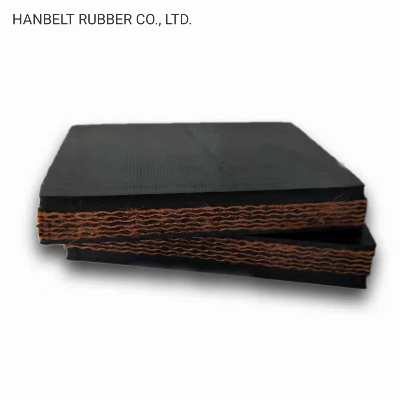HEAT RESISTANT CONVEYOR BELDescription: The heat-resistant conveyor
belt is a heat-resistant conveyor belt made of multilayer rubber
cotton canvas (polyester cotton cloth) or polyester canvas covered
with high-temperature or heat-resistant rubber, bonded together by
high-temperature vulcanization, suitable for conveying below
175ºC hot coke Carbon, cement, molten slag and hot castings, etc.
It is mainly used in metallurgy, construction and other industries
to transport high-temperature materials such as sinter, coke,
cement clinker, etc. The material temperature does not exceed
800ºC, and the belt surface temperature does not exceed
220ºC. 1.TypeThe heat resistant conveyor belt is divided into
ordinary heat-resistant conveyor belt and strong heat-resistant
conveyor belt. The strength layer of ordinary heat-resistant belt
is polyester cotton canvas (CC56), and the strength layer of strong
heat-resistant belt is EP (specifically, it is divided into EP100
type, EP150 type, EP200 type, EP250, EP300, EP350, EP400,
etc.).2.Structure and characteristics(1)Main structure: It is
composed of a high-temperature burning layer, a transition layer,
an organic thermal insulation layer, a strength layer and a
heat-resistant layer.(2)Features: The cover rubber produces a
microporous carbonized layer when exposed to high temperatures,
which is resistant to burning and can prevent the further transfer
of heat to the belt body, reducing the internal strength of
the belt. The carbonized layer generates irregular small cracks
during the operation of the belt body, which can make the belt body
have a cooling effect.(3).Heat resistant temperature gradeThe
heat-resistant conveyor belt can be divided into five types:Type
I :can withstand test temperature not greater than 100 ºC,
the highest short-time operating temperature is 150 ºC, code
T1.Type II :It can withstand the test temperature of not
more than 125ºC, the highest short-time operating temperature is
170ºC, and the code is T2. TypeIII:It can withstand test
temperature not more than 150ºC, maximum short-time operating
temperature is 200ºC, code T3. Type IV: can withstand test
temperature not greater than 175ºC, the highest short-time
operating temperature is 400ºC, code T4. .Type V: can withstand
test temperature not more than 240ºC, maximum short-time operating
temperature is 600ºC, code T5. 3.Application:Heat resistant
conveyor belt is mainly used to transport high-temperature
materials, such as sinter, hot coke, cement clinker, hot castings,
etc. According to the main performance of resistance to tropical
damage and loss of conveying capacity and different heat resistance
levels, EPDM or styrene butadiene rubber are used as covering
rubber respectively; High strength and high permeability polyester
canvas or cotton canvas as a strong layer. The heat-resistant
conveyor belt is made of multi-layer rubber cotton canvas
(polyester cotton cloth) covered with high-temperature or
heat-resistant rubber and bonded by high-temperature vulcanization.
It is suitable for conveying hot coke, cement, slag and hot
castings below 175 ºC.4.main parameter Fabric MaterialFabric
StructureFabric codeLayersCovering Rubber ThicknessMeridional
directionLatitudinal directionTopBottomCotton
canvasCottonCottonCC-563-82.0-10.01.5-6.0Nylon
CanvasNylonNylonNN1003-8NN125NN125NN150NN200NN250NN3003-6NN350NN400NN5003-5Polyester
canvasPolyestPolyesterEP100 3-8EP125EP150EP200EP250EP3003-6EP350EP400EP5003-55.Production
SpecificationWidth range: 500mm-2200mm Length:
100-300mtr/rollStandard: DIN22102(Z,W,Y,X)
AS1332(N.M),RMA(I,II) SANS1173(A,C,M,N) 6.Maintenance
method(1).During use and storage, the conveyor belt shall be kept
clean, avoid direct sunlight or rain and snow, prevent contact with
acids, alkalis, oils, organic solvents and other substances, and be
one meter away from the heating device.(2).During storage, the
warehouse temperature should be kept between 18-40 ºC and the
relative humidity should be kept between 50-80%.(3).During storage,
the conveyor belt shall be placed in rolls and shall not be folded.
During storage, it shall be turned once a quarter.(4).Conveyor
belts of different types, specifications and layers should not be
connected together, and their joints should preferably be
bonded.The type, structure, specification and number of layers of
conveyor belt shall be reasonably selected according to the service
conditions.(5)Generally, the running speed of the conveyor belt
should not be greater than 2.5 m / s. The materials and materials
with large lumpiness and high abrasiveness.When using fixed
unloading device, low speed shall be adopted as far as
possible.(6)The relationship between the diameter of the
transmission drum of the conveyor and the cloth layer of the
conveyor belt, the matching of the transmission drum and the
redirection drum, and the requirements for the idler groove angle
shall be reasonably selected according to the design regulations of
the conveyor.The feeding
Related products about Heat Resistant Conveyor Belting Ep Polyester Canvas Rubber Belt for Industrial
-
 Waste Tyre Plastic Recycling Machinery Machine Tire Crusher Production Line Rubber Crumb Grinding Machine Equipment Tire Shredder
Waste Tyre Plastic Recycling Machinery Machine Tire Crusher Production Line Rubber Crumb Grinding Machine Equipment Tire Shredder
-
 Stretch Plastic Blowing Pet Bottle Making Blow Molding Machine Bottles Stretch Automatic Pet Bottle Blowing Machine
Stretch Plastic Blowing Pet Bottle Making Blow Molding Machine Bottles Stretch Automatic Pet Bottle Blowing Machine
-
 Waste Plastic Pet Bottle, Water Bottle Flake, PP/HDPE/LDPE PE Film Jumbo Woven Bags Plastic Crusher Machine, Plastic Crushing Washing Recycling Machine
Waste Plastic Pet Bottle, Water Bottle Flake, PP/HDPE/LDPE PE Film Jumbo Woven Bags Plastic Crusher Machine, Plastic Crushing Washing Recycling Machine
-
 Type 2 Wall-Mounted Electric Car Charging Station 7kw /11 Kwelectric Vehicle Charging Station Home Wallbox AC EV Charger Single Phase or 3three Phase
Type 2 Wall-Mounted Electric Car Charging Station 7kw /11 Kwelectric Vehicle Charging Station Home Wallbox AC EV Charger Single Phase or 3three Phase
-
 G-View G12W Wholesale Auto Car LED Headlight Bulb High Power H13 H11 9005 H7 H4 Car LED Headlights LED Car Lights
G-View G12W Wholesale Auto Car LED Headlight Bulb High Power H13 H11 9005 H7 H4 Car LED Headlights LED Car Lights
-
 New Design Porcelain Round Plates Dinner Set for Wedding and Banquet
New Design Porcelain Round Plates Dinner Set for Wedding and Banquet
-
 China 2023 New Design Super Soft 100% Polyester Microfiber Knitted Oversized Decoration Hoodie Blanket
China 2023 New Design Super Soft 100% Polyester Microfiber Knitted Oversized Decoration Hoodie Blanket
-
 Handmade Art Creative Materials Thickened White Paper Cup DIY Disposable Handmade Colored Paper Cup
Handmade Art Creative Materials Thickened White Paper Cup DIY Disposable Handmade Colored Paper Cup



